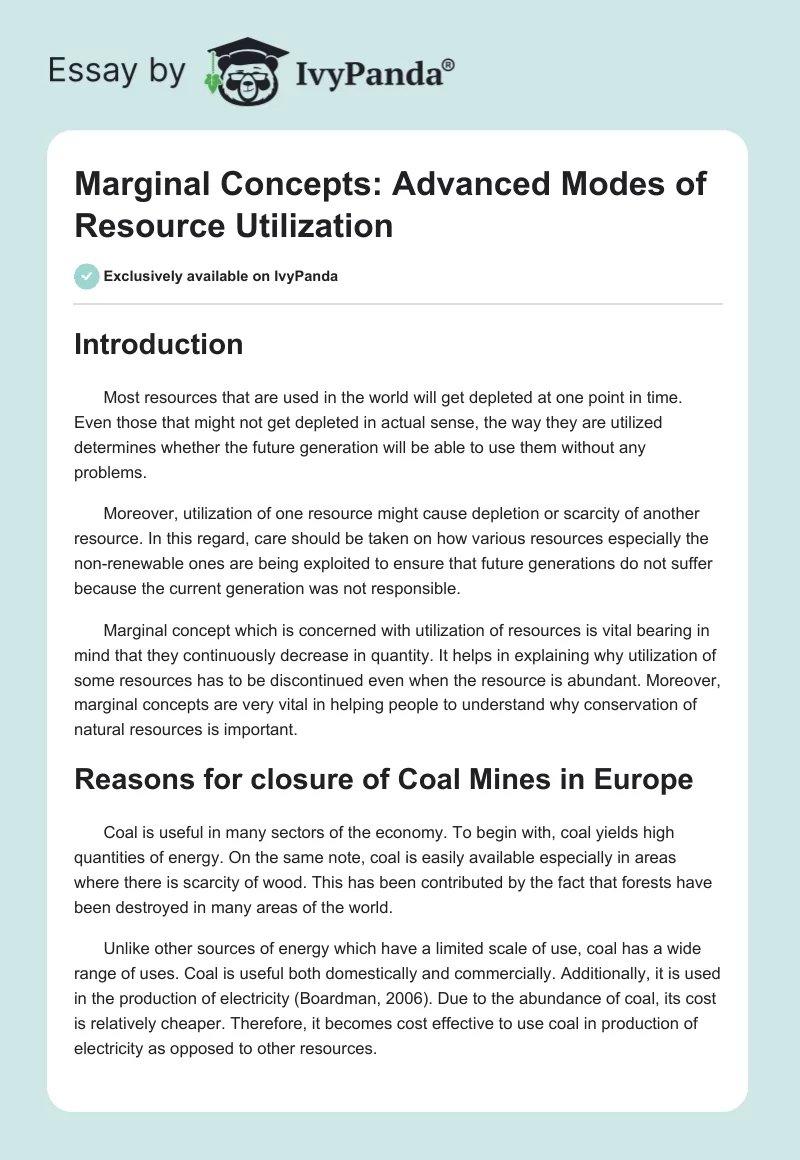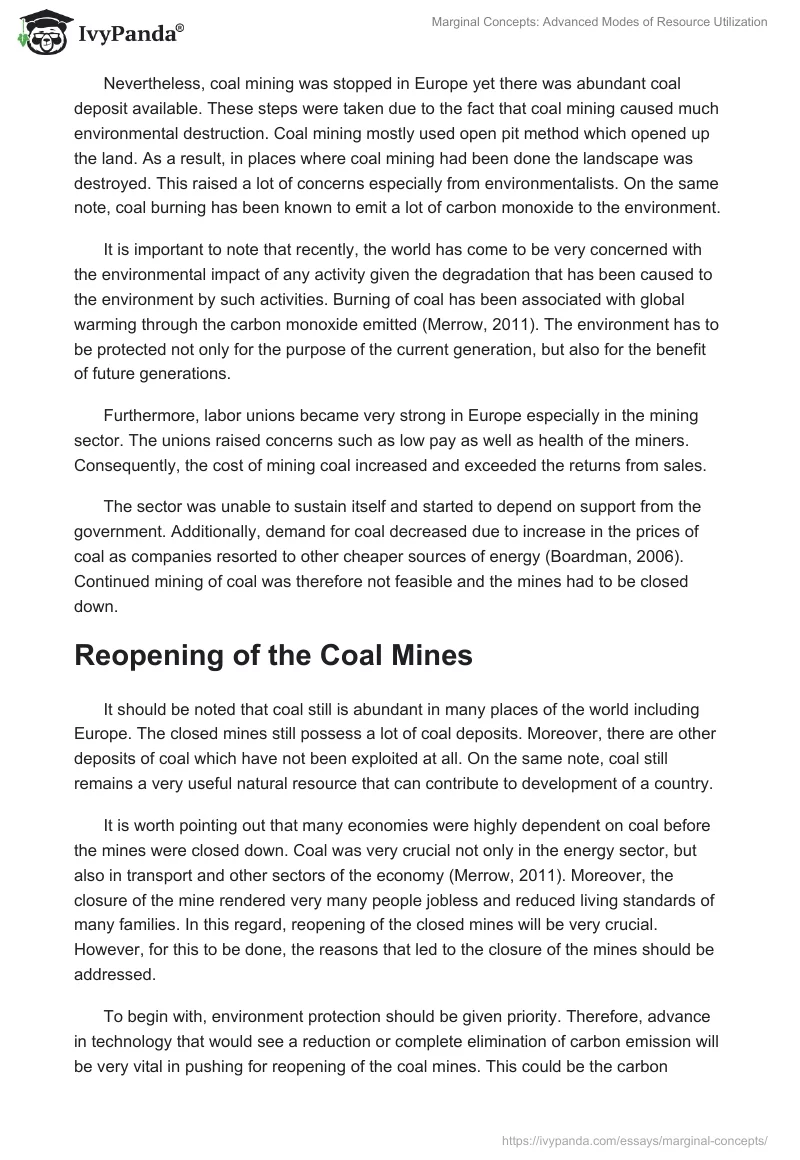Introduction
Most resources that are used in the world will get depleted at one point in time. Even those that might not get depleted in actual sense, the way they are utilized determines whether the future generation will be able to use them without any problems.
Moreover, utilization of one resource might cause depletion or scarcity of another resource. In this regard, care should be taken on how various resources especially the non-renewable ones are being exploited to ensure that future generations do not suffer because the current generation was not responsible.
Marginal concept which is concerned with utilization of resources is vital bearing in mind that they continuously decrease in quantity. It helps in explaining why utilization of some resources has to be discontinued even when the resource is abundant. Moreover, marginal concepts are very vital in helping people to understand why conservation of natural resources is important.
Reasons for closure of Coal Mines in Europe
Coal is useful in many sectors of the economy. To begin with, coal yields high quantities of energy. On the same note, coal is easily available especially in areas where there is scarcity of wood. This has been contributed by the fact that forests have been destroyed in many areas of the world.
Unlike other sources of energy which have a limited scale of use, coal has a wide range of uses. Coal is useful both domestically and commercially. Additionally, it is used in the production of electricity (Boardman, 2006). Due to the abundance of coal, its cost is relatively cheaper. Therefore, it becomes cost effective to use coal in production of electricity as opposed to other resources.
Nevertheless, coal mining was stopped in Europe yet there was abundant coal deposit available. These steps were taken due to the fact that coal mining caused much environmental destruction. Coal mining mostly used open pit method which opened up the land. As a result, in places where coal mining had been done the landscape was destroyed. This raised a lot of concerns especially from environmentalists. On the same note, coal burning has been known to emit a lot of carbon monoxide to the environment.
It is important to note that recently, the world has come to be very concerned with the environmental impact of any activity given the degradation that has been caused to the environment by such activities. Burning of coal has been associated with global warming through the carbon monoxide emitted (Merrow, 2011). The environment has to be protected not only for the purpose of the current generation, but also for the benefit of future generations.
Furthermore, labor unions became very strong in Europe especially in the mining sector. The unions raised concerns such as low pay as well as health of the miners. Consequently, the cost of mining coal increased and exceeded the returns from sales.
The sector was unable to sustain itself and started to depend on support from the government. Additionally, demand for coal decreased due to increase in the prices of coal as companies resorted to other cheaper sources of energy (Boardman, 2006). Continued mining of coal was therefore not feasible and the mines had to be closed down.
Reopening of the Coal Mines
It should be noted that coal still is abundant in many places of the world including Europe. The closed mines still possess a lot of coal deposits. Moreover, there are other deposits of coal which have not been exploited at all. On the same note, coal still remains a very useful natural resource that can contribute to development of a country.
It is worth pointing out that many economies were highly dependent on coal before the mines were closed down. Coal was very crucial not only in the energy sector, but also in transport and other sectors of the economy (Merrow, 2011). Moreover, the closure of the mine rendered very many people jobless and reduced living standards of many families. In this regard, reopening of the closed mines will be very crucial. However, for this to be done, the reasons that led to the closure of the mines should be addressed.
To begin with, environment protection should be given priority. Therefore, advance in technology that would see a reduction or complete elimination of carbon emission will be very vital in pushing for reopening of the coal mines. This could be the carbon capture or carbon storage facilities that are very vital in reduction of the amount of carbon emitted to the environment. Furthermore, technological advancement in mode of mining will be very important. Open pit mining should be done away with. In the event that open pit mining is unavoidable, the mining companies can commit to restore that area after completion of the mining exercise (Boardman, 2006). The health of miners should also be taken care of. This can be done through insurance of miners against accidents during work.
Given the demand of energy that is ever increasing and the inability to fully exploit the oil reserves present, the demand for energy might exert a lot of pressure on supply and make production of coal feasible. In addition to that, the cost of producing coal has been a great impediment on the mining of coal and any cost reduction method will be feasible. Therefore, mining of coal can also be revived if technology can be improved such that a method of mining that is cost effective is discovered.
If the coal industry will be able to support itself and depend less on the subsidies from the government then it might be profitable to mine coal again in Europe (Merrow, 2011). On the other hand, most industries found it economically feasible to import coal rather than use the local one therefore, if a way is found to make the industries buy local coal then coal mining can be profitable.
Marginal Concepts and the Destruction of Rain Forests
Rain forests form the source of rivers which practically sustain the world. Nobody can survive without water. Moreover, almost every mode of production in the world uses water at one point in time. Rain forests are therefore very crucial since they are the water catchment areas of the world.
They modify the climate of very many parts of the world (Cocks, 1992). On the same note, they are home for a lot of animals which help in balancing the ecosystem. Additionally, rain forests form a very vital source of wood energy. Indirectly too, rain forests sustain production of hydroelectric power. Unfortunately, the forests are under threat given the high rate of exploitation.
Rain forests are not expensive to exploit yet they have very many uses. Therefore, human beings who are always seeking for the cheapest way of production will exploit rain forest. It is demoralizing to note that while people are comfortably exploiting natural resources, nobody cares to replace them. This leads to the threat of their extinction. On the same note, the idea that renewable sources of energy are marginally profitable to exploit has been insisted in recent years.
Among the sources of energy that has been termed to be renewable is wood. Consequently, rain forests have been exploited indiscriminately without taking into consideration the future of these forests. In addition, since people can easily exploit natural forests without paying anything, they are likely to overexploit the forests (Cocks, 1992). This, coupled with the fact that governments are reluctant to secure these natural resources, leads to destruction of the rain forests.
Importance of Marginal Concepts in Conservation of Natural Resources
The knowledge of marginal concepts is very vital in exploitation of resources. It makes people aware that whatever resource that is available for exploitation now will not be there forever. In this regard, the knowledge informs people that available resources should be conserved for future use.
It is important to note that oil is one of the most important resources in the world. Oil is the main ingredient in the in the transport sector. Almost all vessels of transport use oil as a source of energy. In the production sector, oil is the main source of energy for the industries (Merrow, 2011). In a nutshell, the world is practically driven by oil. Unfortunately, oil is not renewable and if care is not taken, oil deposits will be depleted in the near future.
Marginal concepts can be used to conserve instead of destroying natural resources. Firstly, by coming up with less costly ways of extracting oil, the prices of oil will reduce and this will in turn make oil more affordable thus, saving other natural resources that have been destroyed due to high prices of oil like natural forests.
On the same note, coming up with a marginally profitable way of oil extracting might also include environmental friendly methods which will help in conserving the environment and other natural resources. It is important to note that, marginal concepts may also help in coming up with ways of reclaiming the environment after a well has been exhausted thus making it economically viable (Boardman, 2006).
On top, understanding marginal concepts can help in discovery of methods of crude oil extraction and refining that are more efficient and which reduce the amount of oil extracted for a given purpose. This will also help in conserving crude oil as a natural resource.
Conclusion
Natural resources are not there forever as many people would think. Their quantity definitely reduces each and every day as they are exploited. It is important to note that the world is very much dependent on natural resources. As a result, depletion of these resources will be catastrophic to the economy of the world as a whole.
Advanced modes of resource utilization should be explored to limit environmental effects that have been increasing of late. Consequently, the knowledge marginal concepts is very crucial in ensuring that natural resources are conserved so that they can be used for a longer periods of time.
References
Boardman, A. E. (2006). Cost Benefit Analysis: Concepts and Practice. Hoboken: John Wiley and Sons.
Cocks, D. (1992). Use With Care: Managing Australia’s Natural Resources in the Twenty-First Century. Wales: UNSW Press.
Merrow, E. W. (2011).Industrial Megaprojects: Concepts, Strategies and Practices for Success. Upper Saddle River: Prentice Hall.


